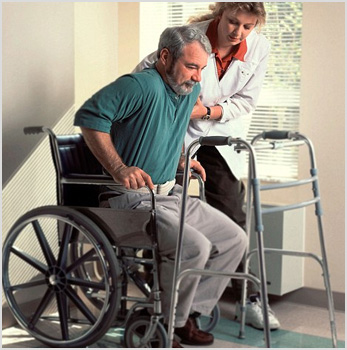|
Paralysis is a loss of muscle function in part of the body. It can be partial or complete, temporary or permanent, and localized or generalized. Most patients feel no pain in the paralyzed areas of their bodies. They also have no control over how those muscles move. Paralysis can affect any part of the body at any time in a person's life.
 Cause Cause
Some patients are born paralyzed. Others develop paralysis after an accident or medical condition. Common causes of paralysis include:
• Stroke
• Spinal cord injury
• Multiple sclerosis (ms)
• Cerebral palsy
• Post-polio syndrome
• Traumatic brain injury
• Neurofibromatosis
• Birth defects
A study published in 2004 showed that 29 percent of paralysis patients become paralyzed from a stroke. The study also showed that 23 percent of patients become paralyzed from spinal cord injuries.
Symptoms of paralysis
Paralysis can be classified in a number of different ways. For example, it can be localised, affecting a particular part of the body, or generalised, affecting a wider area.
Examples of localised paralysis include:
• facial paralysis – which is usually limited to one side of the face
• paralysis of the hand
• paralysis of the vocal cords – vocal cords are bands of tissue and muscle used to generate speech; paralysis usually only affects one vocal cord, which means the person is able to speak but their voice will be hoarse
Examples of generalised paralysis include:
• monoplegia – where one limb is paralysed
• hemiplegia – where the arm and leg on one side of the body are paralysed
• paraplegia – where both legs are paralysed, or sometimes the pelvis and some of the lower body
tetraplegia (also known as quadriplegia) – here both the arms and legs are paralysed
Temporary and permanent paralysis
Paralysis can either be temporary or permanent.
Bell's palsy is a relatively common cause of temporary paralysis that causes temporary facial paralysis.
Sometimes paralysis that occurs after a stroke can also be temporary.
Paralysis caused by serious injury, such as a broken neck, is usually permanent.
Partial or complete paralysis Paralysis can be:
• partial – where there is some muscle function and sensation; for example, if a person can move one leg but not the other, or feel sensations such as cold and heat
• complete – where there is complete loss of muscle function and sensation in affected limbs
Spastic or flaccid paralysis Paralysis can be:
• spastic – where muscles in affected limbs are unusually stiff or display spasms, and movements are not under the control of the individual
• flaccid – where muscles in affected limbs are floppy and weak; muscles in flaccid paralysis may shrivel
People with spastic paralysis may experience muscle weakness with spasms
People with flaccid paralysis often experience muscle weakness without spasms.
In some conditions, such as motor neurone disease or cerebral palsy, it is possible to experience episodes of spastic paralysis followed by flaccid paralysis, or the other way around. |